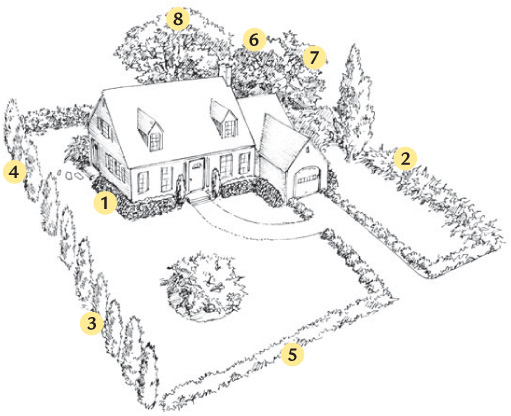
The way you prune a hedge varies according to its purpose. You can trim it into a tight and formal shape or allow it to grow loose and natural. You can make it tall, medium, or short — or, if you want, you can sculpt the top into towers and turrets. If you’re starting from scratch, you can create an evergreen or deciduous hedge, or one that produces fruit or flowers.
Caring for a hedge is not difficult, yet as you drive around, it’s obvious that many gardeners are not skilled in the art. Just like an old-time barber may want to trim a stranger’s long wild hair, keen gardeners feel the urge to stop their cars, grab their shears, and start clipping an overgrown, neglected hedge.
Q What are some ways I can use hedges in my garden?
A Hedges of various kinds are important landscape additions. You can use a hedge to (1) create an attractive border or backdrop, (2) mark property lines, (3) shield out traffic noise and fumes, (4) hide unattractive views, (5) discourage trespassing (human and animal), (6) ensure privacy, (7) form windbreaks or snow traps, and (8) shelter nesting birds.

Q I just planted a hedge. Do I need to prune right away?
A To encourage bushiness to the ground, cut back any tall shoots or broken roots on container-grown shrubs (don’t prune side shoots) at planting. For the first year, limit other pruning to removing broken branches. The larger the initial leaf space, the faster the tree will settle in.
If you’re planting some bare-root deciduous shrubs, cut them back by one-third after planting to promote bushiness and low branching.
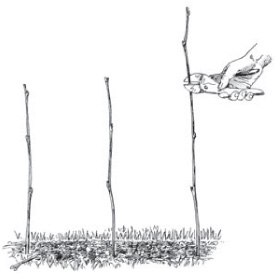
Q When should I start pruning a new hedge?
A You can begin shearing in the second or third year. Even if you want your hedge to grow to 4 feet, don’t wait until it gets to that height before you start to shape it. In order to have a tall, tight hedge, you should first develop a small, tight hedge and then let it grow larger gradually. Just as it is difficult to make a single, tall, loose-growing tree compact and bushy, it’s no easy job to tighten up a large, loose-growing hedge.
Q What’s the correct way to shear a formal hedge?
A The amount of shearing depends upon the specific plant and whether the hedge is formal or informal. You’ll need to trim an informal hedge only once or twice a year, although more vigorous growers, such as privet and ninebark, may need additional clippings. Formal hedges need even more attention during their growing season, especially fast growers; clip while new growth is less than 12 inches and remove stray shoots as needed. Shearing hedges is easy if you follow these guidelines:
 Always shear a hedge so that the bottom is wider than the top. Otherwise, lower branches, lacking their full share of sunlight, will thin out and soon die. The difference may be barely noticeable, but it is extremely important.
Always shear a hedge so that the bottom is wider than the top. Otherwise, lower branches, lacking their full share of sunlight, will thin out and soon die. The difference may be barely noticeable, but it is extremely important.
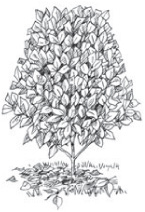
 Unless you have an excellent eye for such things, you should use a template or put up posts and a string as a guide when you’re shearing long, straight, formal hedges, so that you don’t end up with a lopsided row.
Unless you have an excellent eye for such things, you should use a template or put up posts and a string as a guide when you’re shearing long, straight, formal hedges, so that you don’t end up with a lopsided row.
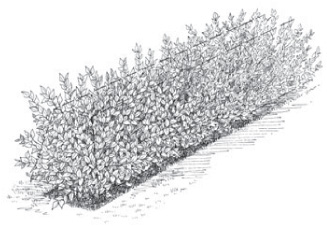
 Don’t shear off the top of a hedge and ignore the sides. Soon it becomes irregular and too wide and sags under the weight of heavy rains, ice, or snow. If anything happens to an individual plant, you can replace it much more easily if your hedge is slender.
Don’t shear off the top of a hedge and ignore the sides. Soon it becomes irregular and too wide and sags under the weight of heavy rains, ice, or snow. If anything happens to an individual plant, you can replace it much more easily if your hedge is slender.

Q Last winter, heavy snow ruined my beautiful flat topped hedge. Is there another shape that would work better?
A Hedges with rounded or pointed tops work best in snowy winter sites. Snow can squash a flat-topped hedge under its weight. Follow these tips for good-looking hedges:
A box effect (A) works best where snow loads are not too heavy. Keep the bottom slightly wider than the top, so all branches get sunlight.
If sides are too straight (B), the lower branches may not get enough sunlight and thus die out.
In areas with heavy snows, round off the top of the hedge to help it shed snow, as in shapes (C), (D), and (E).
If you want a more informal look, avoid shearing; instead, clip individual branches as needed to control size (F).
The top of hedge (G) is too wide, making this shape undesirable — the sun can’t reach lower limbs and snow will crush the top.
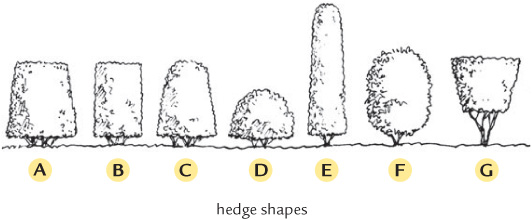
 Most needled evergreens make their growth early, so you won’t need to shear them after midsummer.
Most needled evergreens make their growth early, so you won’t need to shear them after midsummer.
 Prune most deciduous plants, like privet, ninebark, and barberry, after the spring growth flush. They grow for a longer period, so you can trim them off and on for much of the summer, depending upon the formality of the hedge.
Prune most deciduous plants, like privet, ninebark, and barberry, after the spring growth flush. They grow for a longer period, so you can trim them off and on for much of the summer, depending upon the formality of the hedge.
 Broadleaf evergreens such as boxwood and Japanese holly also grow over a long period, so hedges may need some clipping throughout the season.
Broadleaf evergreens such as boxwood and Japanese holly also grow over a long period, so hedges may need some clipping throughout the season.
 Prune flowering hedges directly after the blooms have faded so that new buds can set for the following year. (Rose hedges are the exception and are best pruned in early spring or late fall. Prune back in the summer only if they are growing too tall or too wide.)
Prune flowering hedges directly after the blooms have faded so that new buds can set for the following year. (Rose hedges are the exception and are best pruned in early spring or late fall. Prune back in the summer only if they are growing too tall or too wide.)
Q I have both holly and forsythia hedges bordering my yard. When is the best time to prune them?
A Prune forsythia and most flowering hedges right after bloom, before plants form buds for next year’s flowers. The best time for trimming hollies and most nonflowering hedges is after the plants make their fastest growth. This varies with the type of plant. Do not prune in late summer and fall. New growth may not harden, making plants vulnerable to winter damage. This holds true for both formal and informal hedges. If you have plenty of space, forsythia makes a glorious big hedge when planted at a distance from the house and left to keep its natural arching form.
Trim your hedge when it looks like it needs it. Just as you wouldn’t wait for your lawn to become a field before mowing it, you shouldn’t plan to trim your hedge just once during the growing season. Not only will repeated trimming make it thicker and better looking, but it will also be healthier because it will expend less of its energy on useless growth. If your hedge needs more than a trim, wait until plants are dormant (late winter to early spring, before growth starts).
Q I’m planting a hedge between the front and back yards. How can I go from front to back without leaving a gap in the hedge?
A A big gap can look awkward. For a more graceful effect, why not make an arch in your hedge? Whether you choose a hedge archway or one made of vines, you should shear or clip it every year so it grows thick and bushy. If you keep the sides narrow enough to allow light to enter, the branches on the underside of the arch will stay green and growing. You can also train a freestanding arch over a flagstone path as a garden accent.
 The simple method: Plant two tall-growing trees 4 to 6 feet apart to act as the sides. (Note: They should be far enough apart so that by the time they have grown thick and full, you will still have enough room to walk or take a lawn mower through the opening.) In the spring, when they are starting to grow actively, bend them over carefully to the desired height and tie them together to form the arch. Within a few years, they will grow together.
The simple method: Plant two tall-growing trees 4 to 6 feet apart to act as the sides. (Note: They should be far enough apart so that by the time they have grown thick and full, you will still have enough room to walk or take a lawn mower through the opening.) In the spring, when they are starting to grow actively, bend them over carefully to the desired height and tie them together to form the arch. Within a few years, they will grow together.
 Cheating: Build a wooden trellis in the proper shape and plant a vine to cover it. If you choose a compatible vine, it will look very much like a part of the hedge.
Cheating: Build a wooden trellis in the proper shape and plant a vine to cover it. If you choose a compatible vine, it will look very much like a part of the hedge.
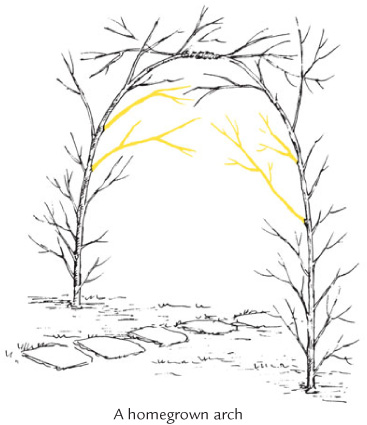
Q We stopped pruning an old hedge a few years ago. How do we revive it so we can put the house on the market?
A You may be faced with an overgrown hedge, with plants that are too tall, too wide, or growing out of kilter with each other. If the plants are healthy, you can sometimes cut them back nearly to the ground and allow them to start over. Your chances for success are best with a deciduous hedge — privet, ninebark, pyracantha, potentilla, lilac, bayberry, or spirea, for example.
You can also cut back and renew certain evergreens. Yew, boxwood, and holly will often respond well to a severe pruning. But spruce, pine, fir, and hemlock can seldom be rejuvenated in this manner, and arborvitae will survive a hard pruning job only if the plants are young. If your overgrown hedge is made of these evergreens, either shape into a tall, informal hedge or take them out altogether and start over with new plants.
Q Which cutting tools can I use to clip a hedge?
A Electric hedge shears make hedge trimming simple. They’re fast, easy to handle, precise, and less tiring to use than hand shears. However, hand shears with long handles and blades are excellent if you don’t have to shear a great deal. A shearing knife is convenient for informal shearing but not accurate enough to use for formal work.
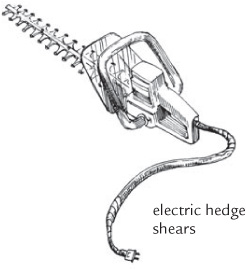
Q I’d like to use formal hedges to divide my garden into separate outdoor rooms. Which plants are best?
A Although the formal, European style of landscaping is rarely used around American homes these days, tightly clipped hedges are still popular. Some favorites are:
 Arborvitae (Thuja spp.)
Arborvitae (Thuja spp.)
 Boxwood (Buxus spp.)
Boxwood (Buxus spp.)
 European hornbeam (Carpinus betulus)
European hornbeam (Carpinus betulus)
 European beech (Fagus sylvatica)
European beech (Fagus sylvatica)
 Holly (Ilex spp.)
Holly (Ilex spp.)
 Japanese pittosporum (Pittosporum tobira)
Japanese pittosporum (Pittosporum tobira)
 Japanese yew (Podocarpus spp.)
Japanese yew (Podocarpus spp.)
 Yew (Taxus spp.)
Yew (Taxus spp.)
Some popular landscape plants, including several privet species and Japanese barberry, are now considered invasive in many parts of North America. Invasive plants are introduced species that spread aggressively; they endanger native plant species and threaten wildlife habitat. Check with your local Cooperative Extension Service to see if the following plants are troublesome in your area; if they are, choose alternatives for your garden.
Japanese barberry (Berberis thunbergii) is invasive in at least 20 states, including all of New England and the Mid-Atlantic. Many states ban the sale of common or European barberry (B. vulgaris), another invasive, since it is an alternate host for wheat rust and a serious threat to agriculture. Common barberry is present in most of North America.
If you want to grow barberry, use noninvasive species. A good one is William Penn barberry (Berberis × glad-wynensis ‘William Penn’), a spiny, 4-foot rounded shrub hardy in Zones 5–7 (and some parts of 8) with glossy evergreen foliage that turns reddish bronze in fall. A taller alternative (8 feet high and wide), wintergreen barberry (Berberis julianae), has clusters of yellow flowers in spring and black oval fruit frosted white in fall; it is hardy in Zones 6-8 and some parts of Zone 5. species makes a tought informal barrier hedge. Substitute purple leafed wiegela for japanese barberry’s purple cultivars.
Many species of privet (Ligustrum) are invasive. Chinese privet (L. sinense) is a weed throughout the southeastern United States, and European privet (L. vulgare) has seeded itself into the eastern United States and several states farther west. Some good substitutes are American holly (Ilex opaca) and blackhaw viburnum (Viburnum prunifolium).
Some vines are also invasive. Among them are Oriental bittersweet (Celastrus orbiculatus), English ivy (Hedera helix), Japanese honeysuckle (Lonicera japonica), and silver lace vine (Fallopia baldschuanica, formerly Polygonum aubertii). barberry (Berberis vulgaris) privet (Ligustrum vulgare)
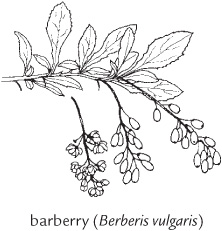
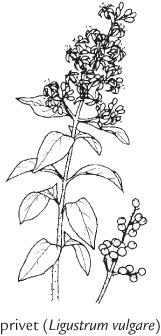
Q Our house sits on a busy corner and we want people to stop cutting across our lawn. What would make a good barrier hedge around our property?
A Sometimes folks plant hedges to keep out unwanted visitors, human or animal. Living fences are often cheaper to establish and maintain than real fences, and they appear less hostile.
In time and with careful pruning, most plants can be grown into a barrier hedge, but dense, thorny, rugged plants are best if you have a choice. Clip or shear your plants in the summer, when they are actively growing. Do it once over lightly — just enough to produce a thick, informal hedge — or frequently and severely to achieve a neater, more symmetrical, and more formal appearance. In either case, follow the general rules for shearing, and never allow a plant to grow wider at the top than at the bottom. These barrier hedges are favorites:
 Beach rose (Rosa rugosa)
Beach rose (Rosa rugosa)
 Colorado blue spruce (Picea pungens)
Colorado blue spruce (Picea pungens)
 Firethorn (Pyracantha coccinea)
Firethorn (Pyracantha coccinea)
 Flowering quince (Chaenomeles spp.)
Flowering quince (Chaenomeles spp.)
 Hawthorn (Crataegus spp.)
Hawthorn (Crataegus spp.)
 Holly osmanthus (Osmanthus heterophyllus)
Holly osmanthus (Osmanthus heterophyllus)
 Osage orange (Maclura pomifera)
Osage orange (Maclura pomifera)
 Variegated five-leaf aralia (Eleutherococcus sieboldianus ‘Variegatus’)
Variegated five-leaf aralia (Eleutherococcus sieboldianus ‘Variegatus’)
 William Penn barberry (Berberis × gladwynensis ‘William Penn’)
William Penn barberry (Berberis × gladwynensis ‘William Penn’)
 Wintergreen barberry (Berberis julianae)
Wintergreen barberry (Berberis julianae)
SEE ALSO: Shaping Hedges, starting on page 157.
Q I need a hedge but I don’t want a green wall. What are my options?
A Ordinarily, plants don’t produce flowers or fruit well when they’re sheared into a tight hedge pattern. But many flowering shrubs work well as a hedge if you allow them to grow naturally, pruning to encourage denser growth and to remove weak or crossing branches rather than shearing. The following make beautiful informal, lightly pruned hedges:
 Buddleia (Buddleia spp.)
Buddleia (Buddleia spp.)
 Cotoneaster (Cotoneaster spp.)
Cotoneaster (Cotoneaster spp.)
 Crab apple (Malus spp.)
Crab apple (Malus spp.)
 Firethorn (Pyracantha coccinea)
Firethorn (Pyracantha coccinea)
 Forsythia (Forsythia × intermedia)
Forsythia (Forsythia × intermedia)
 Glossy abelia (Abelia × grandiflora)
Glossy abelia (Abelia × grandiflora)
 Honeysuckle (Lonicera spp.)
Honeysuckle (Lonicera spp.)
 Lilac (Syringa spp.)
Lilac (Syringa spp.)
 Mock orange (Philadelphus coronarius)
Mock orange (Philadelphus coronarius)
 Oleander (Nerium oleander)
Oleander (Nerium oleander)
 Rose (Rosa spp.)
Rose (Rosa spp.)
 Saint-John’s-wort (Hypericum spp.)
Saint-John’s-wort (Hypericum spp.)
 Viburnum (Viburnum spp.)
Viburnum (Viburnum spp.)
Q My job and family chores don’t leave me much time for gardening. What are some low-maintenance plants I can use for hedging?
A Gardeners with limited time, or those who don’t especially like to putter around the garden, may prefer to have hedges that require little care. Informal hedges need less maintenance than formal hedges. Consider a mix of flowering shrubs rather than just one type of plant.
If you don’t mind a little pruning, choose plants you can clip quickly and easily. Upright-growing shrubs with fine twigs and small needles or leaves are easier to trim than coarser-limbed, spreading varieties or those with larger leaves or longer needles.
A young, growing hedge needs less attention than a mature hedge that has reached the size you want. Often one annual pruning is enough for evergreens in their formative years, but after the hedge is mature, one heavy pruning and a few additional light ones over the course of a season may be necessary to keep it looking good.
A Few Good Evergreen Choices
Arborvitae (Thuja spp.)
Cherry laurel (Prunus laurocerasus)
Glossy abelia (Abelia × grandiflora)
Holly (Ilex spp.)
Inkberry (Ilex glabra ‘Compacta’)
Littleleaf boxwood (Buxus microphylla)
Spruce (Picea spp.)
Upright yew (Taxus cuspidata ‘Capitata’)
A Few Good Deciduous Choices
Crab apple (Malus spp.)
Forsythia (Forsythia × intermedia)
Hedge cotoneaster (Cotoneaster lucidus)
Hedge maple (Acer campestre)
Koreanspice viburnum (Viburnum carlesii)
Renaissance spirea (Spiraea × vanhouttei ‘Renaissance’)
Rose of Sharon (Hibiscus syriacus)
Summersweet (Clethra alnifolia)
Q How can I keep my informal flowering hedge attractive as it matures?
A When flowering shrubs become too straggly, remove some stems to the ground or cut back the branches to an outward-facing branch or bud at different heights inside the crown. The shrubs will grow fuller and more compact. This care is especially important to keep plants looking nice in hedges and borders.